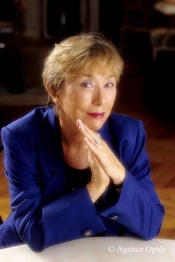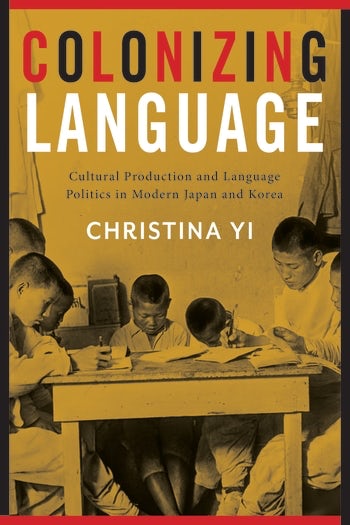Julia Kristeva and Thought in Revolt

In honor of Women in Translation Month, this week we are celebrating Julia Kristeva. Today, we are happy to bring you an excerpt from a Times Literary Supplement piece about her impact on literary criticism, psychoanalysis and semiotics.
Remember to enter our drawing for a chance to win a copy of The Enchanted Clock! Click here for a full list of Kristeva novels published by Columbia University Press.
• • • • • •
Julia Kristeva (b. 1941) is not a philosopher in the formal sense. She was not educated in the discipline (although coming from communist Bulgaria, she did, albeit unsystematically, absorb the ideas of Hegel and Marx). Her work does not pertain exclusively to any of the commonly accepted domains of philosophical inquiry, although her projects continue to have an impact on them. Rather, she has frequently been called a linguist (even though her oeuvre includes studies in semiotics and literary theory), a psychoanalyst (her approach is of a very particular Freudian bent that includes a focus on the feminine and maternity), or a novelist (which is true, but the point to note is that there is a crossover between novelistic content and theoretical and analytical work).
In 2004, Kristeva was awarded the first Holberg International Memorial Prize for innovative work on issues, “at the intersection between linguistics, culture and literature”. And the chairperson of the Holberg selection panel noted that: “Julia Kristeva . . . demonstrates how advanced theoretical research can also play a decisive role in public social and cultural debate in general”. Regarding the latter, Kristeva has applied her psychoanalytic insights to the issues of young children and language acquisition, to adolescence and the importance of the need to believe that self-harm and violence (“radical evil”) can be ameliorated, as well as to the way psychoanalysis can transform existing approaches to disability.
“Kristeva’s work may not have started out being philosophical, but it has had profound philosophical effects.”
But how did it all start? Having been awarded a French government bursary Julia Kristeva left communist Bulgaria – where her Russian Orthodox family continued to live – and arrived in Paris during the Christmas of 1965. Her education had been both francophone and Francophile, and the young scholar duly embarked on a doctorate supervised by the sociology of literature specialist, Lucien Goldmann (1913–70).
Although this doctorate on the emergence of the “text” of the modern novel (see Le texte du roman, 1970) would be widely acclaimed, the initial interest of French academics and intellectuals in Kristeva related to her knowledge of the work of the Russian formalists (including Roman Jakobsen’s theory of language) and, in particular, to her knowledge of the work of the Russian literary theorist, Mikhail Bakhtine (1895–1975) and his concept of the dialogical novel (exemplified by Fyodor Dostoyevsky) and his reinvigorated theory of carnival. Roland Barthes invited Kristeva to speak on the subject at the École des Hautes Études in Paris, as did the literary theorist, René Girard, who had recently moved to America.
At the same time Kristeva began attending Roland Barthes’s seminars, and it was he who recommended that she introduce herself to the writer, Philippe Sollers, then the Editor of the avant-garde journal, Tel Quel. The pair hit it off on both intellectual and personal fronts and married in 1967 (the marriage, which might have perplexed some of the ’68 generation, also enabled Kristeva to remain in Paris after the expiration of her student visa). Sollers’s novels have been a constant point of reference in Kristeva’s literary analyses, especially in the 1970s. Like Jean-Paul Sartre and Simone de Beauvoir, Kristeva and Sollers made their relationship exemplary of two individuals maintaining their love for each other and for their difference and independence – or, as they put it, for remaining “foreign” to each other.
Kristeva’s work may not have started out being philosophical, but it has had profound philosophical effects. Apart from her novels (which deserve a separate study), Kristeva’s intellectual and philosophical innovation is evident in her work in semiotics, poetic language, feminism and in commentaries – inspired by psychoanalysis – on society and politics. In her approach to semiotics, Kristeva coined the term “semanalyse”. This refers to a theory of the sign coupled with the study of the emergence of the text of the modern novel in the fifteenth century. Given the diversity of novelistic writing, how could we find a universal characterization? Kristeva’s answer is that before the novel, fictional texts tended to be closed – a closure exemplified by the epic, the myth, folk or fairy tales. Modern scholars of a structuralist bent (such as Vladimir Propp) had already argued that these earlier texts can be described as a series of symmetrical transformations, which gives them an air of predictability. Kristeva defined this as “disjunctive” symmetry, where one half of the tale (good, for example) is symmetrically opposed to the other half (evil), and the two halves, structurally speaking, mirror each other.
“The innovation in Kristeva’s approach to the novelistic text of the sign is twofold: firstly, it is not only open-ended, but it is also open to the outside – to existence in all its complexity.”
The modern novel, by contrast, is “non-disjunctive”: opposites – the positive and the negative – are of equal value and can flow into one another so that the text becomes open-ended and heterogeneous. More could always be added. The novel is thus a segment of a continuum – perhaps the ultimate example being Finnegans Wake. The novelistic text is called the text of the sign, whereas the epic is the text of the symbol. While the meaning of the sign is contextual and is constituted in its relation to other signs, the text of the symbol tends to have a fixed meaning, one that evokes (what passes for) an eternal verity, a moral idea or a snippet of wisdom.
The innovation in Kristeva’s approach to the novelistic text of the sign is twofold: firstly, it is not only open-ended, but it is also open to the outside – to existence in all its complexity. Indeed, it incorporates the outside within itself, which could take the form of references to current historical events (Joyce, for example, evokes the history of Ireland in Finnegans Wake). It is this fact of incorporation that Kristeva marked with the concept of “ideologeme”.
Secondly, Kristeva recognizes that there is a carnivalesque aspect to the novel, by which she means that it is not reducible to the law of contradiction. Its logic, or principle of operation, is not that of the “either/or” of non-contradiction, but of the “both/and” – of “one and the other”, thus defying contradiction as traditionally understood. In short, its “logic” is equivalent to “ambivalence”: for example, Dostoyevsky’s novels, as “dialogical” (to use Bakhtin’s term favoured by Kristeva), contain multiple points of view, some of which are clearly contradictory; it is thus neither one thing nor the other, but can be both simultaneously, something that implies that it cannot be explained by an either/or logic. This is also – or even primarily – the law of poetic language. A text exemplifying the structure of both “symbol” and “sign” would be an instance of “intertextuality”, another key term in Kristeva’s early work.
“The innovation in Kristeva’s approach to the novelistic text of the sign is twofold: firstly, it is not only open-ended, but it is also open to the outside – to existence in all its complexity.”
Consequently, literary criticism, to the extent that it, like philosophy, has been traditionally beholden to the law of contradiction (also the law of identity: for identity is strictly one thing and not anything else) is called upon to reinvent itself. This means, too, that literary theory is called on to account for the text as (dynamic) productivity, not just as a (static) product. The critic must now ask not only: “how might I describe this?”, but: “where am I located in this?” For the critic comes to realize that he or she is also ensconced in language and is therefore part of the context of the text being analysed. A disturbance of some magnitude has thus occurred in the landscape of thought – all the more profound because the tools (linguistic, philosophical) used to analyse communicative language (the domain of traditional linguistics) are no longer adequate for analysing the novel and poetic language. Many a critic has not been able (or willing) to keep pace with this.








